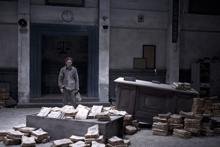Chen Chieh-jen
dal 3/3/2008 al 11/5/2008
Segnalato da
Museo Nacional Centro de Aret Reina Sofia
3/3/2008
Chen Chieh-jen
Museo Nacional Centro de Arte Reina Sofia, Madrid
Military Court and Prison

Chen Chieh-jen (Taoyuan, Taiwan, 1960) is one of the most important artists to come out of the current Asian art scene. His works offer a critical reflection on power strategies, digging in the recent history of his country to retrieve specific situations that reveal mechanisms of control, violence, subjugation and alienation. At the same time, they use visual languages to explore the complex relationships between images and power. His work has been selected to participate in renowned biennials, such as the ones in Sao Paulo (1998), Venice (1999 and 2005), Kwangju (2000), Shanghai (2004), Liverpool and Sydney (2006) and Istanbul (2007). Recently, the Asian Society and Museum of New York put together a retrospective show on his video art.
Chen grew up under the dictatorship that the Kuomintang party imposed on Taiwan until 1991. His father was a soldier in the KMT army, transferred to the island in 1949. He lived in a neighborhood predominated by mixed couples, with Chinese fathers and Taiwanese mothers. Near his home there was a jail for political prisoners, which also served as a military court during the years of Martial Law (1947-1987). This prison has lingered in Chen's memory, and he alludes to it in Military Court and Prison, the work we show here.
In the early Eighties, Chen belonged to various groups of alterative artists. He took an interest in performance during years of intense cultural activity, in a context that was calling for the end of the military dictatorship led by General Chiang Kai-Shek. 1987, the year Martial Law was lifted, represents the starting point of a contemporary art important in its own right after nearly 30 years of dictatorship. This is not to forget the important role played, since the Seventies, by Taiwanese intellectuals in their demand for democracy and cultural identity. Since then, Taiwanese society has changed very rapidly. Surrounded by so much change, Chen tries to make sense of the complex political, social and cultural relationships underlying his country. To do this, he searches the places of his childhood and in the national memory. With this attitude he returns to his artistic practices.
In 1996 he begins the series of black and white photographs Revolt in the Soul & Body, in which he digitally alters historic photographs of massacres, adding himself as a victim and tyrant at the same time. In his second series, 12 Karmas Under the City, he shows a future straight out of the scenes of a Hollywood sci-fi film, examining how cinematic fiction works as a tool that conditions our jaded vision of the present and future.
In 2002 he shoots his first video: Lingchi- Echoes of a Historical Photograph, inspired by a famous photograph of torture, which Georges Bataille also used in his work The Tears of Eros to reflect on pain and ecstasy. One of the many photographs/postcards that circulated around Europe during the colonial era and shaped its idea about Chinese culture, is ironically almost unknown in China and Taiwan. It depicts the torture known as “death by 1000 cuts”. Chen reinterprets this image as the response of the “Other,” re-thinking “history” and revealing that which has been deliberately concealed and forgotten.
The Factory (2003) shows the impact that the effects of globalization and offshoring have had on workers in industrial Taiwan. Bade Area (2005) reveals these same effects on the urban landscape, where the process of transformation erases all traces of the past and perspective on the future. On Going (2006) explores politics in Taiwan and its relations with the US during the Cold War. In The Route (2006), based on a shipbuilders' strike in Liverpool during the Thatcher era, Chen reproduces a fictitious strike by Taiwanese shipbuilders, denouncing Taiwan's isolation on the international scene.
Military Court and Prison (2007-2008) consists of two videos, the first nearly one hour long and the second approximately five minutes in length. The longer one is more personal, having to do with Chen's memories about the prison and military court near his family home in Taipei County. The other video represents the official view provided by the government about the years of dictatorship or Martial Law in Taiwan. This is his first work with sound, as opposed to his previous works done in slow-motion and in silence, two technical characteristics of his work. The main character is a political dissident who has been locked up in this prison for a long time, symbolizing a person who has been forgotten by all: he is a ghost. The actors that move in circles, monitored by the lens of a video-surveillance camera, are temporary workers, a hospital caregiver from continental China, poverty-stricken people and social activists. They all represent modern-day Taiwanese society. But, as Chen suggests, the individuals featured in his video could be from anywhere else in the world. The inmate from the political prison represents the past; government control under Martial Law. The rest are today's prisoners, restricted by the law due to the temporary nature of their jobs or for the mere fact of being foreigners. They all live together in the same, decrepit space.
The Taiwanese government has recently converted this prison into the Taiwan Human Rights Memorial.
Museo Nacional Centro de Aret Reina Sofía
Calle Santa Isabel, 52 - 28012 Madrid
Time: Mondays to Saturdays: 10.00 - 21.00
Sundays: 10.00 - 14.30
Close on Tuesday



